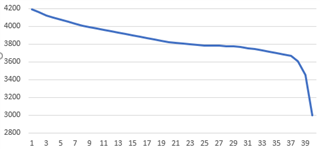Other Parts Discussed in Thread: BQSTUDIO, GPCCHEM, , BQ27Z561
Hi,
Here below are my battery spec,
| Lithium Ion INR18650 M36T 12.50Wh Specs | |
| Nominal energy | 12.50Wh |
| Minimum energy | 12.10Wh |
| Nominal voltage | 3.63V |
| Standard charge current | 1000mA (0.3C) |
| Charge end voltage | 4.2V |
| Charge cut-off current | 50mA |
| Max. charge current | 1000mA (0.3C) at 0-24C, 2330mA (0.7C) at 24-50C |
| Max. discharge current | 5000mA |
My doubt is that what are the things I have to do to configure battery gauge. Like what are the registers I have to configure to set battery voltage and battery capacity. Also how I can do it?
After setting those, I can give standard commands through I2c and I can get my battery status information?.





